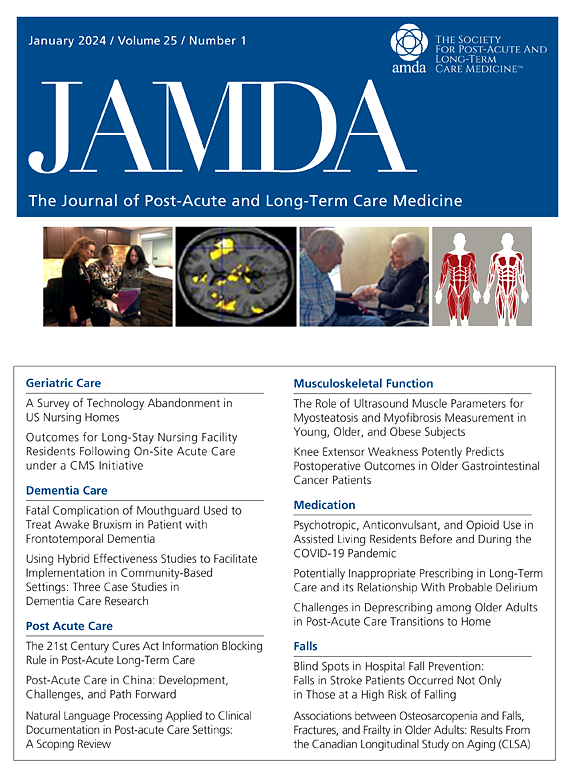Antithrombotic Therapy and Mortality Risk in Older Adults with Hip Fractures
IF 4.2
2区 医学
Q2 GERIATRICS & GERONTOLOGY
Journal of the American Medical Directors Association
Pub Date : 2025-06-07
DOI:10.1016/j.jamda.2025.105690
引用次数: 0
Abstract
Objectives
Antithrombotic therapy, including antiplatelet therapy, direct oral anticoagulants (DOACs), and vitamin K antagonists (VKAs), is increasingly prescribed. These therapies pose complex challenges in patients with hip fracture due to risks of bleeding, risks of thromboembolism, and their potential role as markers of frailty. However, limited real-world evidence exists regarding their risks and benefits in this population. This retrospective cohort study examines the association between antithrombotic therapy and mortality in older patients with hip fracture.
Design
Retrospective cohort study.
Setting and Participants
Patients with hip fracture admitted to a level 1 trauma center between January 2021 and December 2022.
Methods
Data on clinical characteristics, antithrombotic therapy, and outcomes were collected from health records. Mortality was analyzed using Kaplan-Meier curves and Cox proportional hazards regression, adjusting for age, sex, comorbidity, functional status, surgery, kidney function, body mass index, and nursing home residency. Secondary outcomes included transfusion rates and thromboembolic events.
Results
Among 526 patients (median age, 82 years; 69% female), 1-year mortality rates were 14.3% for no antithrombotic therapy, 21.0% for antiplatelet therapy, 26.4% for DOACs, and 48.9% for VKAs. At 2 years, mortality rates increased to 20.9%, 30.4%, 32.1%, and 61.7%, respectively (log-rank P < .001). In the fully adjusted model, the mortality risks associated with antiplatelet therapy [hazard ratio (HR), 0.71; 95% CI, 0.45-1.12] and DOACs (HR, 0.99; 95% CI, 0.54-1.81) were no longer significant compared with patients without antithrombotic therapy, whereas VKAs remained significantly associated with increased mortality (HR, 2.17; 95% CI, 1.22-3.83). Secondary outcomes revealed that all antithrombotic therapies were linked to delayed surgery and higher transfusion rates. However, neither delayed surgery nor transfusions independently predicted mortality.
Conclusions and Implications
VKA use is associated with significantly higher mortality in older patients with hip fracture and may identify a subset at substantial risk of poor outcomes. These findings underscore the need for careful assessment and management of VKA users and further research to confirm these observations.
老年髋部骨折患者的抗血栓治疗和死亡风险。
目的:抗血栓治疗,包括抗血小板治疗,直接口服抗凝剂(DOACs)和维生素K拮抗剂(VKAs),越来越多地被开处方。由于出血的风险、血栓栓塞的风险以及作为虚弱标志的潜在作用,这些治疗方法对髋部骨折患者提出了复杂的挑战。然而,关于它们在这一人群中的风险和益处,现实世界的证据有限。这项回顾性队列研究探讨了抗血栓治疗与老年髋部骨折患者死亡率之间的关系。设计:回顾性队列研究。环境和参与者:2021年1月至2022年12月期间在一级创伤中心收治的髋部骨折患者。方法:从健康记录中收集临床特征、抗血栓治疗和结果的数据。使用Kaplan-Meier曲线和Cox比例风险回归分析死亡率,调整年龄、性别、合并症、功能状态、手术、肾功能、体重指数和养老院居住情况。次要结局包括输血率和血栓栓塞事件。结果:526例患者(中位年龄82岁;无抗血栓治疗组的1年死亡率为14.3%,抗血小板治疗组为21.0%,doac组为26.4%,vka组为48.9%。2年后,死亡率分别增加到20.9%、30.4%、32.1%和61.7% (log-rank P < 0.001)。在完全校正模型中,抗血小板治疗与死亡风险相关(危险比[HR], 0.71;95% CI, 0.45-1.12)和DOACs (HR, 0.99;95% CI, 0.54-1.81)与未接受抗栓治疗的患者相比不再显著,而vka仍与死亡率增加显著相关(HR, 2.17;95% ci, 1.22-3.83)。次要结果显示,所有抗血栓治疗与延迟手术和更高的输血率有关。然而,延迟手术和输血都不能独立预测死亡率。结论和意义:VKA的使用与老年髋部骨折患者的死亡率显著升高相关,并可能确定一个预后不良风险较大的亚群。这些发现强调了对VKA用户进行仔细评估和管理以及进一步研究以证实这些观察结果的必要性。
本文章由计算机程序翻译,如有差异,请以英文原文为准。
求助全文
约1分钟内获得全文
求助全文
来源期刊
CiteScore
11.10
自引率
6.60%
发文量
472
审稿时长
44 days
期刊介绍:
JAMDA, the official journal of AMDA - The Society for Post-Acute and Long-Term Care Medicine, is a leading peer-reviewed publication that offers practical information and research geared towards healthcare professionals in the post-acute and long-term care fields. It is also a valuable resource for policy-makers, organizational leaders, educators, and advocates.
The journal provides essential information for various healthcare professionals such as medical directors, attending physicians, nurses, consultant pharmacists, geriatric psychiatrists, nurse practitioners, physician assistants, physical and occupational therapists, social workers, and others involved in providing, overseeing, and promoting quality

 求助内容:
求助内容: 应助结果提醒方式:
应助结果提醒方式:


